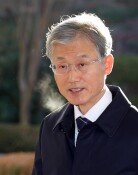Bursting of Golf Bubble?
Traditionally, sales of golf club memberships rise around spring after a long winter but this year has seen a sluggish market. Demand for investment purpose purchases have plunged like that for real estate. The membership (price) index announced recently by Ace Golf was 1,249 yesterday, with the figure in the doldrums since February. The index suffered a 27-percent decline from a record high of 1,704 set exactly two years ago. The sluggish golf membership market is probably due to economic conditions and the political situation. The primary reason, however, appears to be a rise in the number of golf courses across the nation.
Korea had 339 country clubs late last year, including 193 membership-based clubs and 146 public clubs, 29 more than in 2008. Analysts predict the number of golf courses will reach within two to three years 470 to 500, an optimal figure considering the population. Golfers welcome the cut in green fees by golf courses in provincial regions following the onset of the economic slump, but the operators of certain golf courses are uneasy. Memberships have declined more than 30 percent in price, so more members are demanding en masse a full refund of membership fee that they paid five years ago as stipulated by the sales agreement.
According to the Korea Leisure Economy Institute, members are expected to seek membership fee refunds worth three trillion won (2.67 billion U.S. dollars) at 21 golf courses this year and 39 courses next year. This could herald the bursting of the golf course bubble, which lays to rest the notion that the prices of golf course memberships always rise. Certain golf courses have been put up for sale. These are signs that highly leveraged golf courses built through project financing or operators of courses that spent huge sums of money to build luxury clubhouses and upscale gardening are poised to collapse. In Japan, after membership prices plunged due to the prolonged recession of the 1990s, a large number of golf club members demanded a refund of their membership fees. As a result, 800 of 2,440 golf courses in Japan went belly up.
In Korea last year, 25.91 million people visited golf courses, up eight percent from 2008, as golf courses in the provinces enjoyed a boom. This was also partially the result of a drop in the number of golfers who went abroad to play due to the sluggish economy. Chances are that the number of golf fans will gradually decline in the coming years, as the younger generation prefers computer games, horseback riding and yachting. With Korean women enjoying more rights and opportunities, more young wives will no longer want to become golf widows and this will reduce the number of golfers, analysts say. The government still views golf as a luxury and wasteful sport and accordingly levies heavy taxes on golf courses, but this could be considered an outdated concept.
Editorial Writer Hong Kwon-hee (konihong@donga.com)





![[단독]통일교 ‘한학자 보고문건’에 ‘전재수’ 최소 7번 등장](https://dimg.donga.com/c/138/175/90/1/wps/NEWS/IMAGE/2025/12/22/133015670.1.jpg)

